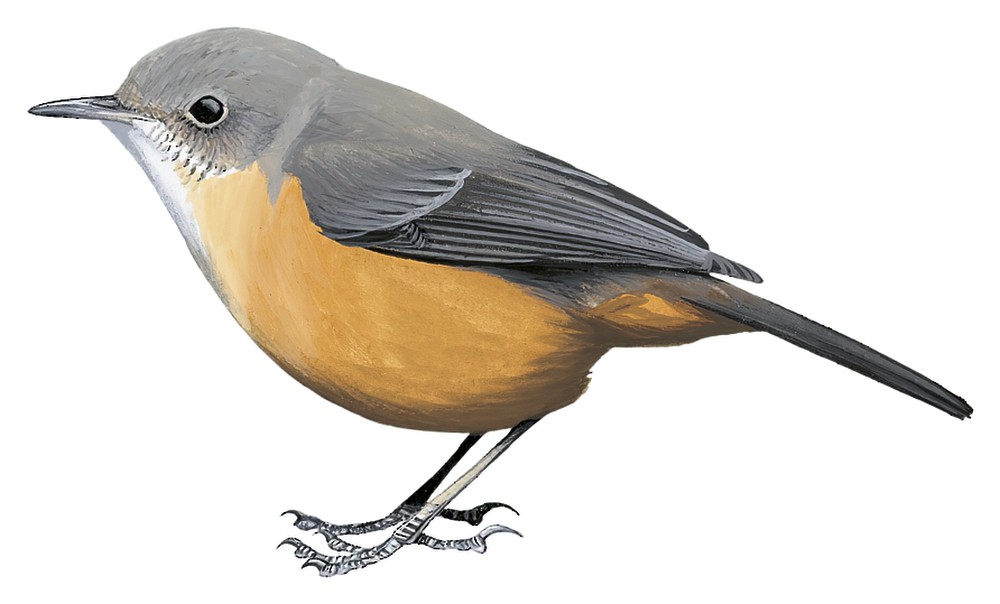Rockwarbler / Origma solitaria

Rockwarbler
SCI Name:
Protonym: Sylvia solitaria BirdsNewHolland p.20 pl.16
Taxonomy: Passeriformes / Acanthizidae / Origma
Taxonomy Code: rocwar1
Type Locality: Parramatta, New South Wales.
Author: Lewin
Publish Year: 1808
IUCN Status: Least Concern
DEFINITIONS
ORIGMA
(Acanthizidae; Ϯ Rock Warbler O. solitaria) Gr. ορυγμα orugma, ορυγματος orugmatos mine, tunnel, excavation < ορυσσω orussō to dig; "it frequents stony gullies and rocky situations in the neighbourhood of caverns, to the roofs of which it attaches its pendant nest" (Gould 1865); "Genus ORIGMA. Bill nearly as long as the head, incurved, carinated, indented near the tip; nostrils oval, lateral, basal, and covered by an operculum; wings moderate, rounded, first quill short, fourth, fifth, sixth, and seventh nearly equal and longest; tail moderate and slightly rounded; tarsi moderate; toes rather short, the outer toe much longer than the inner; plumage dense. Type. Saxicola solitaria, Vig. and Horsf. Rock Warbler of Lewin, pl. XVI." (Gould 1838). Recent work indicates that this genus should include the mouse warblers Crateroscelis.
Var. Orygma.
Synon. Origmella.
solitaria / solitaris / solitarius
L. solitarius solitary < solus, solius alone.
● According to Fraser in P. Sclater 1859a, the Solitary Shrike Tyrant was called “el Solitario” by the Spanish settlers of Ecuador (Agriornis).
● ex “Coucou Solitaire” of Levaillant 1806, pl. 206 (Cuculus).
● ex “Green-headed Bunting” of Latham 1785 (syn. Emberiza hortulana).
● “Solitary Sparrow ... It is wont to sit alone on the tops of ancient Edifices and Roofs of Churches, singing most sweetly, especially in the Morning, whence it took its name” (Ray 1678); "95. TURDUS. ... solitarius. 14. T. cæruleus, remigibus rectricibusque nigris, abdomine lineolis cinereis undulato. Passer solitarius. Willugb. orn. 191. Raj. av. 66. Edw. av. 18. t. 18. Olin. av. 14. Act. Ups. 1750. p. 21. Habitat in Oriente. Mas cæruleus; Femina cinerea, subtus lineolis albis & cinereis undulata." (Linnaeus 1758) (Monticola).
● (Statius Müller 1776) ex “Merle solitaire de Manille” of d’Aubenton 1765-1781, pl. 564, fig. 2 (syn. Monticola solitarius philippensis).
● (J. Gmelin 1789) ex “Passera solitaria” of Olina 1622, “Solitary Sparrow” of Willughby 1676, “Passer solitarius” of Ray 1713, “Merula solitaria” of Brisson 1760, “Merle solitaire” of de Buffon 1770-1783, and “Solitary Thrush” of Latham 1783 (syn. Monticola solitarius).
● ex “Suirirí chorreado todo” of de Azara 1802-1805, no. 196 (Myiodynastes).
● ex “Solitaire” of Leguat 1708, and de Buffon 1770-1783, and “Solitary Dodo” of Latham 1785: “not met with in flocks, scarcely more than two being found together” (‡Pezophaps).
● ex “Solitary Parrot” of Latham 1787 (Phigys).
● ex “Japú negro” of de Azara 1802-1805, no. 58 (Procacicus).
● ex “Oiseau Solitaire” of Carré 1669, and “Solitaire” of Dubois 1674 (this bird was formerly thought to be a species of dodo Raphus) (‡Threskiornis).
● ex “Ynambú Mocoicogoé” of de Azara 1802-1805, no. 332 (Tinamus).
● "This new species inhabits the watery solitudes of our highest mountains during the summer, from Kentucky to New York" (A. Wilson 1813) (Tringa).
UPPERCASE: current genus
Uppercase first letter: generic synonym
● and ● See: generic homonyms
lowercase: species and subspecies
●: early names, variants, mispellings
‡: extinct
†: type species
Gr.: ancient Greek
L.: Latin
<: derived from
syn: synonym of
/: separates historical and modern geographic names
ex: based on
TL: type locality
OD: original diagnosis (genus) or original description (species)












